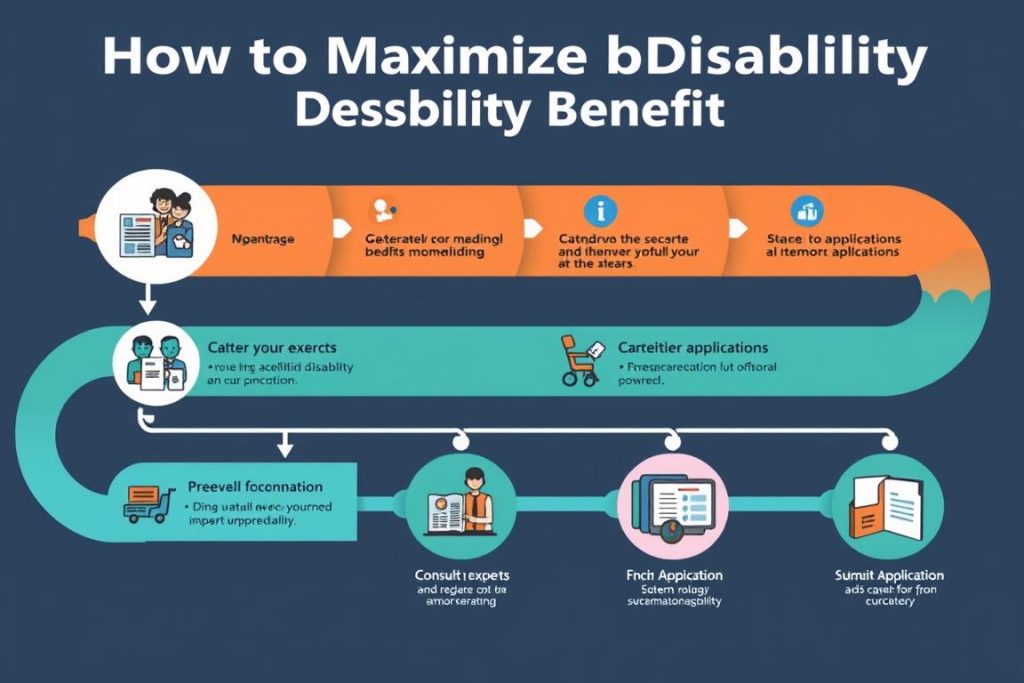The room was silent and filled with hope as the financial advisor started to talk. People sat around with tired but hopeful looks. They all had their own stories of health struggles and the search for steadiness. The chance for a new beginning was in the air, thanks to the possibility of getting up to $3,822 each month from Social Security Disability Insurance (SSDI) for those who qualify. It felt like the moment before a new year starts. People were ready to tackle the challenging process of qualifying for disability and understanding the medical conditions needed for claims. For many, learning this could mean moving from constant financial trouble to getting a stable monthly income. This income would honor their work history and acknowledge their health issues.
Not many people know, but the top monthly amount from SSDI in 2024 will be $3,822. This amount shows a response to inflation and a desire to help those in need. Yet, the average monthly benefit is about $1,489.26. This makes it crucial to understand the system and its details1. The range of eligible conditions is wide but specific, from severe neurological or mental health issues to ongoing problems with bones or lungs12. There’s also support for young ones with congenital or developmental problems, under Childhood Listings1. Having a clear grasp can help unlock these benefits. These benefits are meant to offer some normalcy in the midst of life’s unexpected trials.
Think about cases like adults waiting for a heart transplant or dealing with cancers that can’t be operated on3. Such situations are not only qualifying conditions but also show an urgent need for support. Programs like Compassionate Allowances offer quick help3. As the Social Security Administration (SSA) carefully checks claims based on the seriousness of conditions and how they affect daily life, it’s evident that knowing SSDI can lead to significant financial support and increased stability for many12.
Key Takeaways
- Know your eligibility for SSDI and the potential for a maximum monthly benefit of $3,822 in 2024.
- Familiarize yourself with the qualifying medical conditions outlined by the SSA, including musculoskeletal and severe mental health issues.
- Recognize the role of compassionate allowances for those with significant medical conditions needing expedited benefits.
- Understand that the SSA meticulously evaluates disability claims, ensuring that those who qualify can access their rightful benefits.
- Remember that while the fulfillment of SSA’s criteria can result in substantial benefits, the average payout is around $1,489.26 per month.
Having the right knowledge and advice can put you on the path to receiving the support you need. Stay informed and determined, and see if you’re eligible for these important benefits.
Understanding SSDI and Your Eligibility for Benefits
Welcome to a detailed guide on how to secure Social Security disability benefits. This is a crucial safety net for those who cannot work because of serious health problems.
Overview of Social Security Disability Insurance (SSDI)
SSDI is a main source of help for disabled people, funded by payroll taxes. It provides financial aid to individuals and their immediate families. This support helps those with long-term disabilities manage financially. The average monthly payment to a disabled worker is around $1,537. When including family benefits, this can go up to about $2,7204.
Key Criteria for SSDI Eligibility
To get Social Security disability benefits, proving you have a disability is required. You need enough work credits, usually 40, half of which should be from the last ten years before your disability started5. SSDI only covers severe disabilities that will last a year or lead to death. This ensures only those truly in need get help4.
The Importance of Meeting Disability Criteria
It’s crucial to understand and meet the disability criteria to get benefits. Conditions that qualify are looked at carefully to make sure they truly stop someone from working. The Social Security Administration checks each claim with a detailed 5-step process, making sure the system is fair5.
Knowing the right information can help you a lot in getting these important benefits. Learn more about how to qualify by visiting qualifying for SSDI benefits4.
Having detailed information and a clear plan can help you navigate SSDI benefits. Being well-informed and proactive boosts your chances of successfully claiming the benefits you deserve. With 1 in 4 of today’s 20-year-olds likely to become disabled before retiring, SSDI’s importance is very clear5.
Medical Conditions for Disability Benefits
Getting disability benefits starts with a detailed disability benefits medical evaluation. You need to know the list of disabilities for benefits that the Social Security Administration (SSA) recognizes as serious conditions.

The SSA’s Blue Book lists these conditions, organizing them by types like muscle, heart, and brain problems6. This book is key for anyone with these health issues trying to get Social Security Disability Insurance (SSDI) benefits6.
To get benefits, especially if you’re under 65, you must show your health problems stop you from working any job. This is based on the SGA standard7. For example, being completely deaf in one ear or some movement problems automatically qualify7.
| Age Group | Evaluation Focus | Presumptive Disabilities |
|---|---|---|
| Under 50 | Ability to engage in any gainful activity7 | N/A |
| 50 and older | Ability to perform past relevant work7 | Immobility without wheelchair, total deafness in one ear7 |
If your health issue isn’t in the Blue Book, don’t give up; you might still get SSDI. You’d have to show your condition is as bad as those listed6. They’ll closely look at your medical records from doctors they trust7.
If they deny your claim, remember you can appeal. You need to follow strict deadlines. Sometimes, getting a lawyer who knows about Social Security Disability can help7. They can help gather and show your medical proof better7.
Knowing how to prove you qualify for benefits can greatly affect your application. Being aware and ready to act are your best tools in dealing with the complex SSDI system.
Maximizing Your Disability Benefits: Steps to Take
To get the most out of Social Security and veterans disability benefits, you need to know the system. We’ll look at important steps and things to think about. These can help increase what you get.
Work History and Its Impact on Benefit Amount
Your work history plays a big role in how much you get from Social Security. They use things like your Average Indexed Monthly Earnings (AIME) and Primary Insurance Amount (PIA). If you’re a veteran with a disability rating of 30% or more, adding family members can up your money8If your health gets worse, checking your benefits again might give you more each month8
Understanding the Role of Medical Evidence
Having strong medical proof is key for SSDI and veterans benefits. This proof shows how serious and long-lasting your condition is. It’s what Social Security needs to see9In Virginia, 70% of first-time SSDI claims are turned down, mainly because the medical proof isn’t enough10
Filing for Social Security Benefits at Full Retirement Age (FRA)
Filing for Social Security at Full Retirement Age means you get the biggest monthly amount. For those who earn a lot, this could be up to $3,8228
This matters a lot for people who’ve carefully planned for retirement. They really focus on getting the most from their money during their retirement years.
It’s important to be ready for delays when applying and to have up-to-date, strong medical proof. This helps you face and beat initial rejections9

| Action | Importance |
|---|---|
| Check Work History | Ensures eligibility and accurate benefit calculation |
| Collect Medical Evidence | Proves disability severity and duration |
| Apply at FRA for Full Benefits | Enables receipt of highest possible benefits |
| Consider Adding Dependents | May increase benefit payments if applicable |
Effectively managing these areas will help you reach your goal of maximizing disability benefits. Look into every option and make sure you fit the eligibility criteria. This can really help improve your financial situation.
Conclusion
Starting your journey to get Social Security disability benefits means knowing the eligibility rules and the medical issues the SSA recognizes. It’s important to show how symptoms like pain, check out with real medical proof and affect your job. Building a strong case that matches the SSA’s criteria is key1112. Your job history and medical records are important in showing how much you can still work.
In California, having a good disability lawyer and using the local SSA resources can really help. They help gather the right proofs for your application. The SSA looks at many kinds of physical and mental problems12. You need to show evidence that truly shows how serious your condition is, meeting the SSA’s standards13.
Show the SSA how your symptoms make daily life and work tough. This path needs toughness, as you may face rejections. Yet, for those who qualify, the benefits are a crucial help. Keeping up with the latest information, using all help available, and quickly giving needed documents can boost your chances of getting the financial aid and healthcare you need with a long-term or permanent disability13.
FAQ
What medical conditions qualify for disability benefits?
How do I know if I am eligible for SSDI?
What are the key criteria for SSDI eligibility?
How much can I receive in SSDI benefits?
What steps can I take to maximize my disability benefits?
Can my family members receive SSDI benefits based on my work history?
What should I do if my medical condition is not listed as a qualifying disability?
What is the importance of meeting disability criteria set by the SSA?
Source Links
- What Medical Conditions Qualify for Social Security Disability – https://sslg.com/what-medical-conditions-qualify-for-social-security-disability/
- Part III – Listing of Impairments (Overview) – https://www.ssa.gov/disability/professionals/bluebook/listing-impairments.htm
- 2024 Compassionate Allowances List (What To Do If Your Condition Is On It) – https://www.atticus.com/advice/general/the-2022-compassionate-allowance-list-and-what-to-do-if-your-condition-is-on
- SSDI and SSI benefits for people with disabilities | USAGov – https://www.usa.gov/social-security-disability
- Disability Benefits – EN-05-10029 – https://www.ssa.gov/pubs/EN-05-10029.pdf
- Common Disabilities That Can Qualify for Social Security Disability Insurance Benefits – https://www.idlawcenter.com/blog/common-medical-conditions-that-qualify-for-ssdi.cfm
- What Injuries and Illnesses Qualify for Social Security Disability? | Law.com LawyerPages – https://lawyers.law.com/article/injuries-illnesses-qualify-social-security-disability.html
- 4 Tips to Maximize Your Veterans Disability Benefits – https://www.alperinlaw.com/blog/maximizing-your-veterans-disability-benefits.cfm
- Social Security Self-Help – https://www.dlcv.org/socialsecurity
- 5 Tips When Seeking a Social Security Disability Benefit – https://www.dlcv.org/5-tips-when-seeking-a-social-security-disability-benefit
- Code of Federal Regulations § 404.1529 – https://www.ssa.gov/OP_Home/cfr20/404/404-1529.htm
- What Automatically Qualifies You for Disability Benefits – https://www.aarp.org/retirement/social-security/questions-answers/medical-conditions.html
- Code of Federal Regulations § 404.1594 – https://www.ssa.gov/OP_Home/cfr20/404/404-1594.htm

